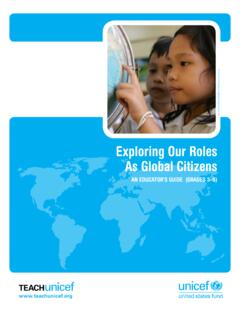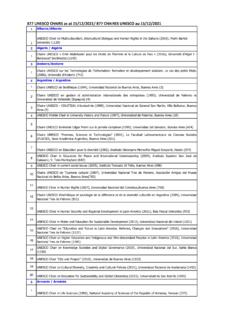Transcription of Global Awareness and Perspectives in Global Education
1 CANADIAN SOCIAL STUDIESVOLUME 38 NUMBER 3, SPRING Special Issue: Graduate Work in Social Studies EducationGlobal Awareness and Perspectives in Global EducationLaura BurnoufUniversity of AlbertaReturn to ArticlesAbstractThis paper examines the whole notion of Global Education by discussingtheoretical and practical understandings by major figures in the field. Globaleducation is a recent addition in social studies and there are many differentunderstandings and conceptual which effectively teach the concepts in schoolsas part of the entire curriculum. A review of the explanation of Hanvey's fivedimensions and the four dimensional model of Global Education by Pike &Selby as well as other figures in the field of Global Awareness and educationare outlined. These understandings are used to form the conclusion that allstudents need to learn about Global issues in school in order to become livingand practicing citizens in our ever changing Global society.
2 In teaching socialstudies the need exists to shift from the Eurocentric way of examining thecurriculum and looking at it from multiple Perspectives . IntroductionIn our rapidly changing society, an urgent need exists for schools to address and infuse globalawareness into curriculum instruction. Students are increasingly confronted with many issuesthat require a Global Education focus. According to Kirkwood (2001), these students will facea new world order thereby creating a need to acquire a Global Education . He states:Their daily contacts will include individuals from diverse ethnic,gender, linguistic, racial, and socioeconomic backgrounds. Theywill experience some of history's most serious health problems,inequities among less developed and more developed nations,environmental deterioration, overpopulation transnationalmigrations, ethnic nationalism, and the decline of the nation state.
3 (Kirkwood, 2001, p. 2)Therefore, I feel that a relevant curriculum is needed to help students of differing worldviewsto understand and function effectively in the social, cultural and economic worlds and to beable to understand the notion of globalization and the role of Global to Werner and Case (1997), movements to promote a Global perspective withinsocial studies are due to the state of the planet as a whole and an understanding of how itssystems political, cultural, economic, ecological, and technological are linked and howthese are manifested in relationships. Werner & Case (1997) introduce the importance ofdiffering Perspectives by stating " Global Education has been associated with curriculumreform advocating a more Global perspective on the world. A need exists for students toexamine the world from varying Perspectives and to become aware of the complexinterrelationships that characterize it" (p.)
4 177).Kirkwood (2001) describes globally educated people as "those who possess high tech skills,broad interdisciplinary knowledge about the contemporary world, and adaptability, flexibility,and world mindedness to participate effectively in the globalized world" (p. 11). Therefore,the teacher needs to strive for and possess the above characteristics in order to validateher/himself as an educated person of the 21st century. Following the crisis of September 11th,Merryfield (2002) posits the question, "Did teachers possess sufficient knowledge of relevantcultures, their beliefs, felt needs, histories, political economies and their past and presentrelationships with the United States to be able to provide students with the necessarybackground information?" (p. 148). This question needs to be further explored and there is nobetter time than now due to the dilapidating state of our planet to begin to address the concernfor a more holistic and deeper understanding of the the above rationale, this paper will discuss the differing interpretations, opinions, anddefinitions of Global Education and how the social studies curriculum can help studentscritically examine their own Perspectives and connections in the local, national, and globallevels.
5 All children, regardless of their race and culture, have a right to be educated and mustbe given tools to help them develop attitudes, knowledge, and skills necessary to becomecompetent, responsible, and humane citizens of their community. Children need to developcross cultural skills and attitudes in order to become effective citizens in a very diverse andpluralistic Global PerspectivesHanvey's Definition: Perhaps the most important step in understanding and incorporating Global Education inclassrooms and communities is to understand and relate to the themes of Global Awareness aspresented by experts in the field. Hanvey (1976), one of the first scholarly experts to give acomprehensive definition of the concept " Global Awareness ", proposes five dimensions thatprepare students to achieve Global Awareness .
6 These include perspective consciousness, state of the planet Awareness , cross cultural Awareness , knowledge of Global dynamics, andawareness of human choices. Haavenson, Savukova, and Mason (1998/99) conducted theirresearch on United States and Russian Perspectives on teacher Education reform and globaleducation and found that these dimensions form the first level known as attitude formationupon which Global Education can be implemented. The second level is the development ofcognition skills and the third level is an integrated view of the world. An explanation ofHanvey's five dimensions, paraphrased by Kirkwood (2001) and Haavenson et al. (1998/99)is provided below and an explanation of the other two levels will be consciousnessPerspective consciousness refers to an Awareness of and appreciation for other images of theworld and that a person's worldview is neither universally shared, nor necessarily right, yetmay be profoundly different.
7 It is the realization that an individual's worldview is both amatter of conscious opinions and ideas and more importantly to subconscious evaluations,conceptions and unexamined assumptions. Perspectives are shaped by ethnic, religious,differences in age, sex, and social status, among many other factors. These differences, asstated by Haavenson et al. (1998/99), "have been one of the main causes of conflict andconfrontation in the history of mankind" ( ).The authors go on to say that, "It is important to teach students to look upon a certainphenomenon or event from different Perspectives so as to encourage respect and appreciationfor beliefs, customs, and values different from their own" (p. 38). It is not only about racialand cultural differences, instead, a pluralistic view needs to be taken when looking at of the planet Awareness State of the planet Awareness requires comprehension of prevailing world conditions,developments, trends, and problems that are confronting the world community.
8 It includes anin depth understanding of Global issues such as population growth, migrations, economicdisparities, depletion of resources, and international conflicts, that require Global learners tobe aware of the world around them. Children need to be made aware that what affects theworld affects them as well. In elementary school, students can be taught to make decisionsabout ways to prevent disaster by studying the consequences of environmental cultural awarenessThis dimension includes the diversity of ideas and practices in human societies and how theseideas and practices are found in human societies around the world, including concepts of howothers might view one's own society as perceived from other vantage points. According toHanvey (1976), this dimension is the most difficult to attain most likely because it refers tothe highest level of Global cognition.
9 The misconception about cross cultural Awareness isthat people consider it no more than a set of stereotypes that do more harm than good assuperficial knowledge engenders prejudice. An effective way to promote cross cultural Awareness , as explained by Haavenson et al.(1998/99), is by showing videos and then having discussions with students about these filmsto help them in separating stereotypical views from those that are more of Global dynamicsKnowledge of Global dynamics refers to an understanding of the world as an interconnectedsystem of complex traits and mechanisms and unanticipated consequences. A high level ofsophistication on the part of the student is required because understanding these processes isdifficult to achieve due to the unanticipated effects on the human condition.
10 It includes aconsciousness of Global change and cannot be acquired through mass media. Haavenson et al.(1998/99) explain that "[s]tudents learn to identify subtle cause effect relationships, anticipateside effects, model processes and make decisions about eliminating or altering undesirableconsequences" (p. 40). Students may be asked to create webs of the factors influencing theissue, to suggest feasible solutions, and to foresee possible side effects of such of human choicesHanvey (1976) challenges Global thinkers to realize the problems of choice confrontingindividuals and nations as consciousness and knowledge of Global systems expand. It isrelated to Global dynamics in such a way that it focuses on making choices and develops asense of responsibility for making decisions made which affect future generations.












